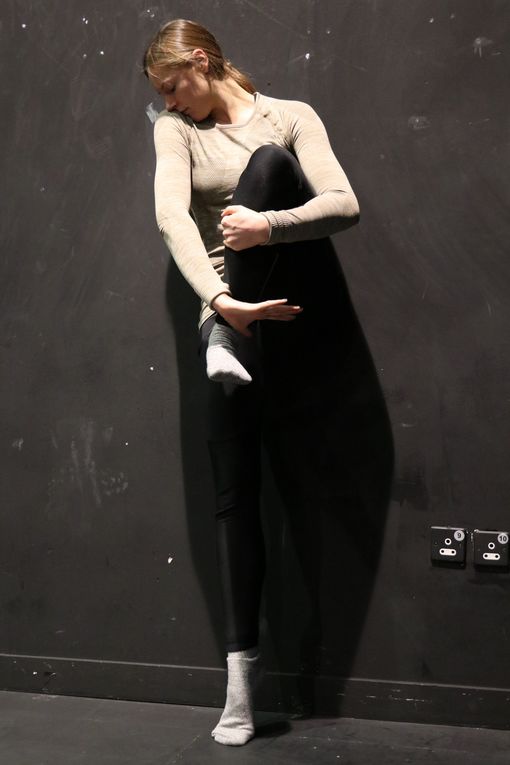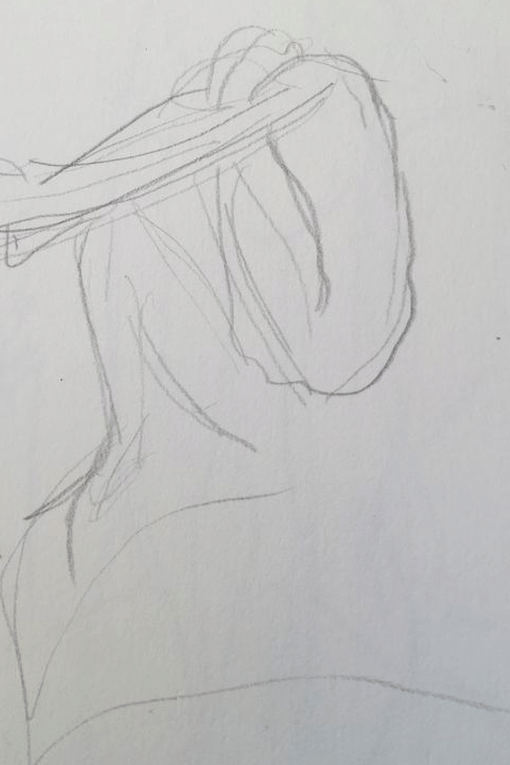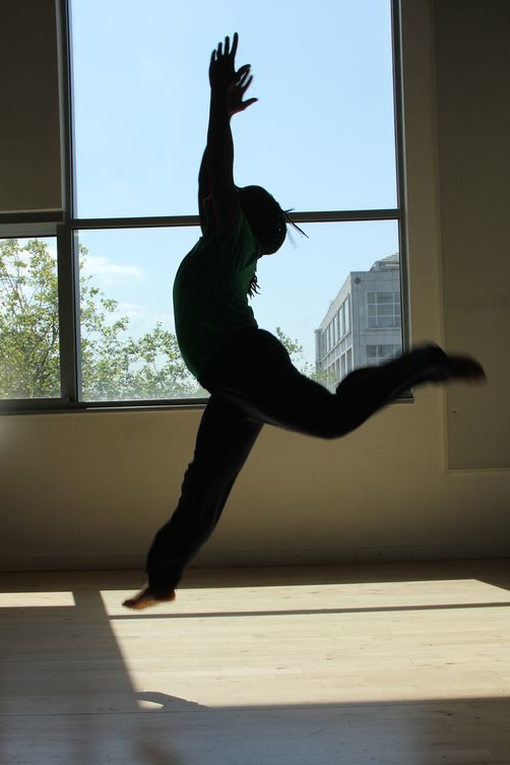Image
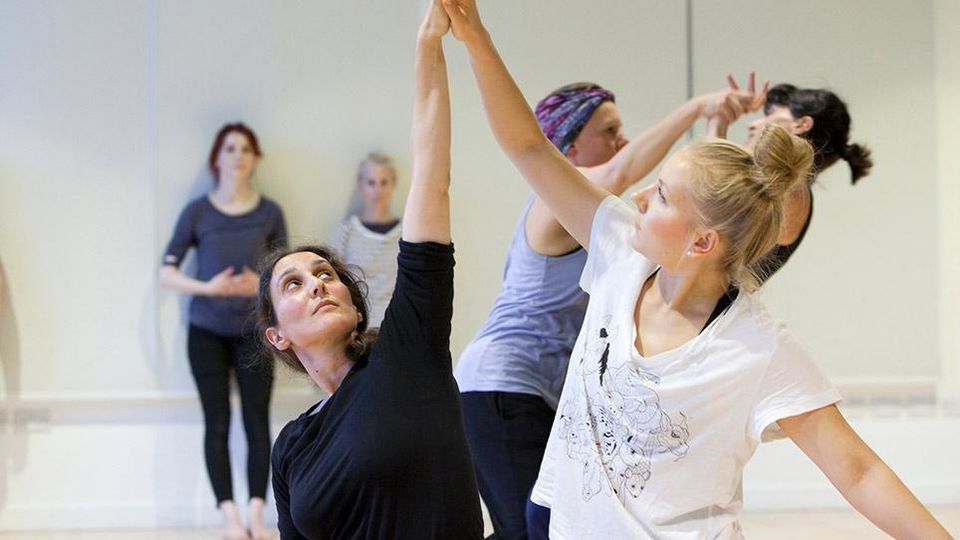
Introduction
The International Community for Movement (ICM) aims to connect and extend the field of actor movement by offering workshops, discussion and talks for professional movement practitioners and actors. The ICM acts as a gathering point for the development of movement teachers, movement directors and other movement practitioners working in theatre, actor training and allied fields.
The MA/MFA Movement: Directing and Teaching course leaders have curated the ICM. The combined specialisms of Vanessa Ewan and Ayse Tashkiran of actor movement pedagogy and movement direction pedagogy inform the events of this community. In the pilot phase we have run a series of creative, teaching research projects and workshops that have shared practices, as well as initiated and responded to questions arising from movement direction and actor movement.
Conservatoire Conversations on Movement (CCM)
The Conservatoire Conversations on Movement (CCM) are movement symposiums which sit beneath the ICM umbrella. These events provide an opportunity for those who teach Movement in conservatoires to connect and seek to share our practice, and talk productively about the implications, discoveries, and challenges of teaching movement today. We wish to utilise this time to support, provoke and inspire each other as we move through the complexity of teaching within current local and global challenges.
Events
Live CCM Event
18 July 2024, 9.00am - 5.00pm
Speakers and full schedule to be confirmed.
Please save the date, more information to follow.
Live CCM Event
28 November 2024, 6.30 - 8.30pm
Two presentations, followed by group discussion.
Please save the date, more information to follow.
Explore the archive of previous events, below
Archive
-
Year Eight 2022-2023
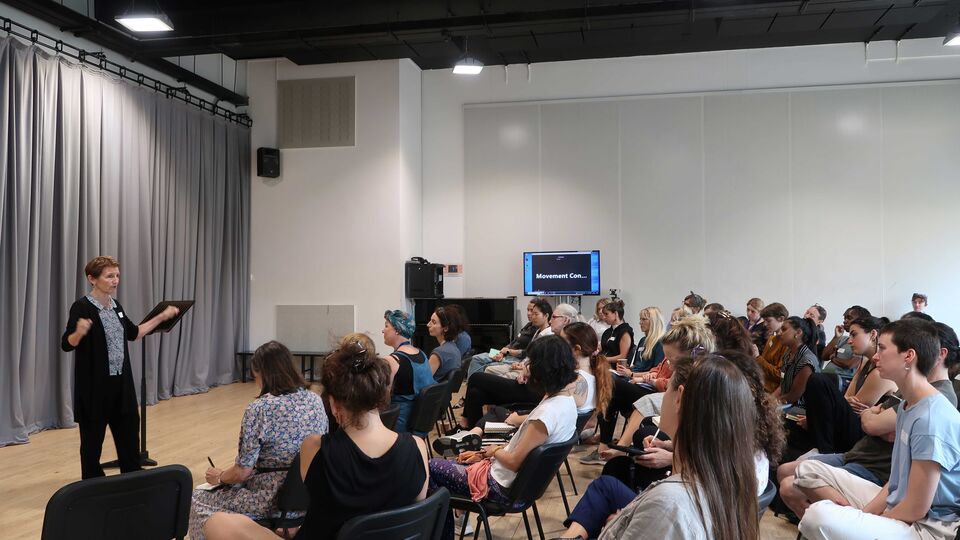 Photo: Hannah Jessop
Photo: Hannah JessopConservatoire Conversations on Movement
13 July 2023, The Royal Central School of Speech and Drama
This all-day event was an opportunity for those of us who teach movement in conservatoires to connect, share best practice, and talk productively about the implications of teaching movement. Within a day-long programme of presentations, provocations, discussions, and plenary, we gave support to and inspired each other as we move through the complexity of teaching in the context of disruptions and re-orientations of the past few years.
Presentations:
- Niamh Dowling ‘Movement Pedagogies as a Framework for Change’
- Ingrid Mackinnon ‘Empathy as a movement practice’
- Claudia Manini ‘Movement Practice and Cultural Diversity’
View the Eventbrite archive page for further details of the programme.
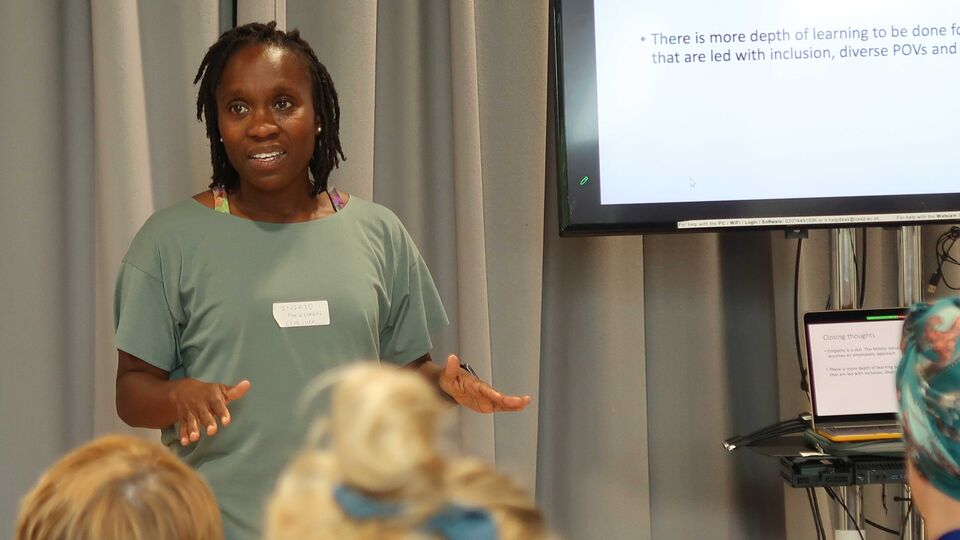 Photo: Hannah Jessop
Photo: Hannah Jessop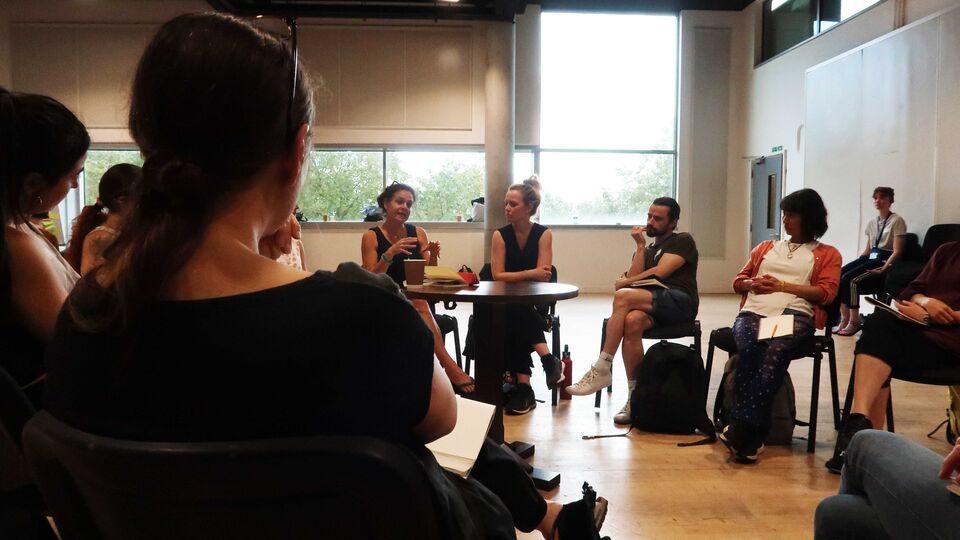 Photo: Hannah Jessop
Photo: Hannah Jessop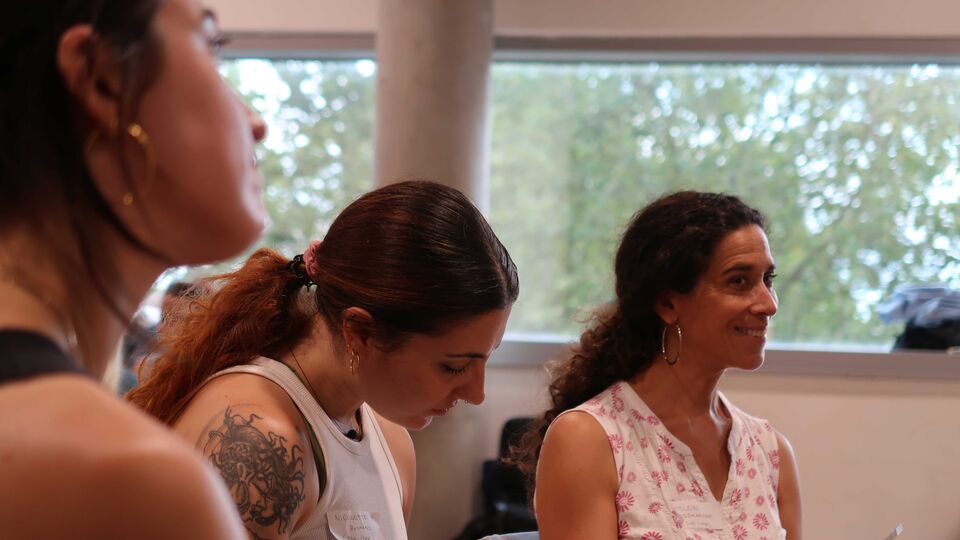 Photo: Hannah Jessop
Photo: Hannah Jessop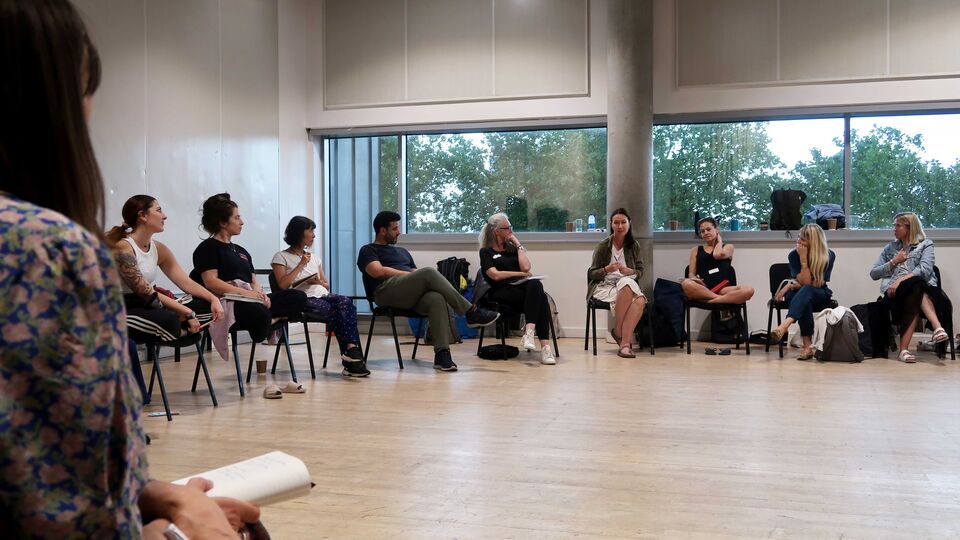 Photo: Hannah Jessop
Photo: Hannah Jessop -
Year Seven 2021-2022
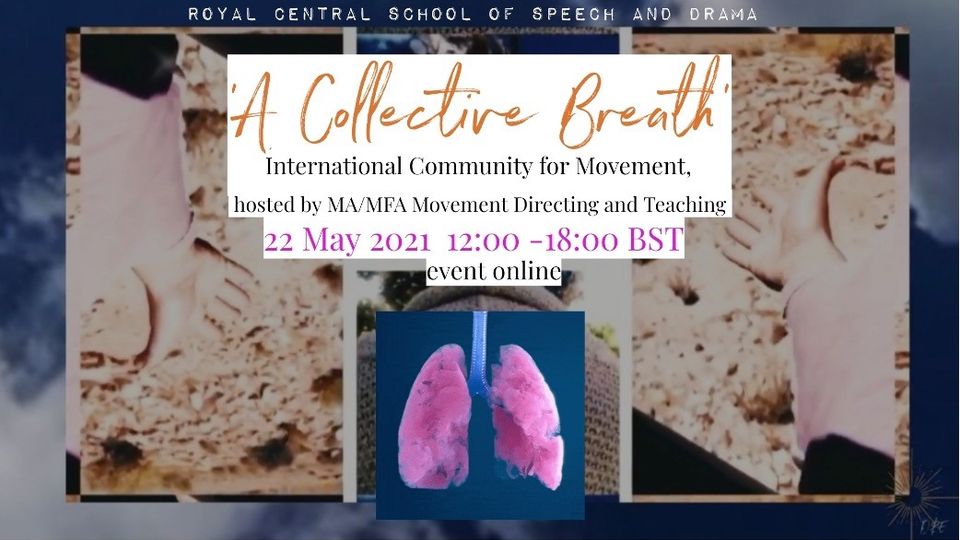
A Collective Breath
Online Event, 22 May 2021 from 12.00pm - 6.00pm BST
A day of virtual workshops co-curated by a team of recent graduates of the MA/MFA Movement: Directing and Teaching. This Zoom event was held across two spaces: a café and a studio. The café opened conversation between movement practitioners with varying experience and from wide ranging contexts. The studio held workshops by an international group of movement practitioners. Participants were invited to a collective warm-up in preparation for the day. All sessions featured BSL interpretation and live captioning.
The Workshops
Kate Kholer Amory – Breath
Kate Kholer Amory shared her somatic understanding of the body and led movers through exploring “what is going to happen as we emerge from this period of isolation, disconnect and perhaps illness and take those first steps into shared space and community? How will we track what has changed in our bodies?” Through inquiry and practice, Kate led participants to “explore employing three important fundamental principles of Somatic Movement: cellular respiration, support proceeds movement and yield proceeds push and reach.”
Kimberley Harvey & Dan Daw – Inclusivity and Movement
Kimberley Harvey led a movement session designed in collaboration with Dan Daw. Participants were led through different explorations and collectively learned repertoire from a previous Candoco Dance Company piece. Kimberley offered the idea of translation, translation of movement material in particular as universal, and offered a practical way to explore this.
Sumana Mandala & Coley Curry – Celebrating Movement Heritages
Sumana Mandala and Coley Curry drew upon Indian movement traditions to share embodied practice and then facilitated a session in which participants created “movement stories through dance and collage to honour our diverse lineages and lived histories, making waves of personal narratives in an ocean of possibility”.
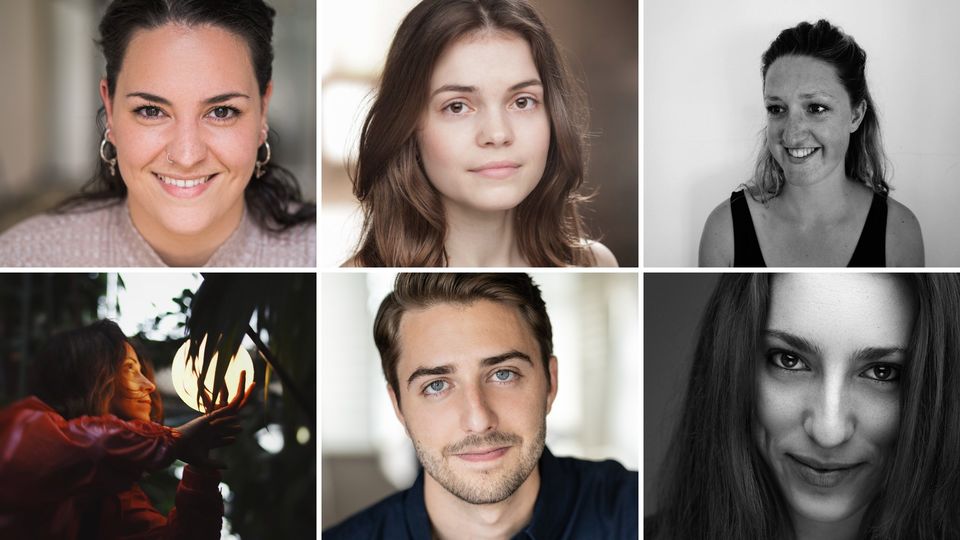
Conservatoire Conversations on Movement
Online Event, Monthly from July- December 2021
These online conversations, hosted by Vanessa Ewan (Central) and Shona Morris (RADA), brought together those that teach movement in conservatoires to connect, share best practice, and talk productively about the implications of teaching movement through a pandemic. Support and inspiration were points of focus as practitioners navigated the complexity of hybrid teaching together. Those from other departments within the conservatoire were also welcome to join or listen into these conversations. This monthly gathering began in July of 2021 and continues in 2022.
Movement Dialogues
Online Event, 11 December 2021 from 3:00pm - 5:00pm GMT
A day of virtual workshops co-curated by a team of recent graduates of the MA/MFA Movement: Directing and Teaching. Practitioners were invited to consider ‘how critical conversations about equity and applications of the technology presently available might facilitate a development of movement practice’. This online event was held across two spaces: a virtual Reading Room hosted on the platform Gather and a live Zoom webinar. The webinar featured BSL interpretation and all offers were captioned.
The Experiences
Marie-Gabrielle Rotie - Audio Movement Journey
This audio journey, based within Butoh practice, was created by Marie-Gabrielle Rotie and brought attention to the self through embodied exploration. This guided practice invited participants to journey through the experiences of ‘blooming’ and ‘withering’. The recording lived within the Reading Room for a period of three weeks, inviting participants to enjoy this practice whenever they chose, to perhaps return to the exercises, and to discuss their experience with others.
Diane Alison-Mitchell, Kane Husbands, & Jennifer Jackson – A Conversation about Equity and Movement
This webinar conversation, chaired by Diane Alison-Mitchell, was a dialogue with movement directors Kane Husbands and Jennifer Jackson. These three discussed their current movement direction practices and the industry, applying the lenses of antiracist, decolonial, and anti-oppressive methodologies.
The Reading Room
The Reading Room was a virtual gathering space that offered participants the opportunity to read, explore movement, and discuss. For a period of three weeks, this space could be experienced individually or serve as a gathering place. The Reading Room contained a multimodal selection of resources, including: Marie-Gabrielle Rotie’s ‘Audio Movement Journey’; Dr. Cass Fleming and Dr. Roanna Mitchell’s articles from the 2020 ‘Against the Canon’ issue of Theatre, Dance, and Performance Training; Diane Alison-Mitchell’s ‘Dancing since strapped to their mothers’ backs: movement directing on the Royal Shakespeare Company’s African Julius Caesar’ from Shakespeare, Race and Performance: The Diverse Bard (2016); a video resource from Vanessa Ewan and Kate Sagovsky’s Laban’s Efforts in Action: A Handbook for Actors with Online Video Resources (2018); a chapter from Ayse Tashkiran’s book Movement Directors in Contemporary Theatre: Conversations on Craft titled ‘Beyond the Room: Contexts and Structures’; as well as links pointing to resources created by Jennifer Jackson, Kane Husbands, Tine Damborg, and Asha Jennings-Grant.
The ICM team offered participants orientation sessions and an access guide to this space.
-
Year Six 2020-2021

Online Event: Conservatoire Conversations on Movement
September/October/November 2021
Vanessa Ewan (Central) and Shona Morris (RADA) would like to invite those that teach movement in conservatoires to the forthcoming ‘Conservatoire Conversations on Movement’.
Dates
- 6.30-7:45pm Thursday 30 September
- 6.30-7.45pm Thursday 28 October
- 6.30-7.45pm Thursday 25 November
About this event
This is an opportunity for those of us who teach movement in conservatoires to connect, share best practice, and talk productively about the implications of teaching movement through a pandemic. We wish to utilise this time to support and inspire each other as we move through the complexity of hybrid teaching.
We ran a series of three this Summer and following positive feedback we are continuing with them into the future.
We have selected the last Thursday of each month as an easy to remember date and while they do occur monthly, there is no obligation to attend every month. We welcome you to one or several or all. They are simply for us, as conservatoire actor movement teachers, (or affiliated movement subjects of Fight or Dance) to dedicate considered time to discussion on areas that relate to teaching through the pandemic and to other areas as they emerge.
We welcome those from other departments within the conservatoire if they would find it of value to simply listen in to the conversations themed on the adjustments we are making and solutions we have found while managing to maintain a Covid-19 safe environment in the studio.
You can book a free place via the links below:
Thursday 30 September 6.30pm
Thursday 28 October 6.30pm
Thursday 25 November 6.30pm
Online Event: Conservatoire Conversations on Movement
July/August 2021
We would like to invite you to our forthcoming ‘Conservatoire Conversations on Movement’, hosted by the International Community for Movement (ICM). This is an opportunity for those of us who teach movement in conservatoires to connect.
Dates
6.30-7.45pm Thursday 24 June
6.30-7.45pm Thursday 29 July
6.30-7:45pm Thursday 26 August
About this event
This is an opportunity for those of us who teach movement in conservatoires to connect, share best practice, and talk productively about the implications of teaching movement through a pandemic. We wish to utilise this time to support and inspire each other as we move through the complexity of hybrid teaching.
This is the first of three meetings to share our ideas and discoveries. We may find that we want to carry on into the future and make the last Thursday of each month a movement meet up for conservatoire movement teachers and dedicate considered time to other areas as they emerge.
The first meeting is themed on the adjustments we are making and solutions we have found while managing to maintain a Covid-19 safe environment in the studio.
You can book a free place via the links below:
Thursday 24 June
https://www.eventbrite.co.uk/e/conservatoire-conversations-on-movement-tickets-154403485983
Thursday 29 July
https://www.eventbrite.co.uk/e/conservatoire-conversations-on-movement-tickets-154404482965
Thursday 26 August
https://www.eventbrite.co.uk/e/conservatoire-conversations-on-movement-tickets-157604397997

A Collective Breath
22 May 2021 12.00pm - 6.00pm BST, online
A day of virtual workshops co curated by a team of recent graduates of the MA MFA Movement: Directing and Teaching. This Zoom event held two spaces, a café and a studio. The café opened conversation between movement practitioners with varying experience and from wide ranging contexts. Participants were invited to a collective warm-up in preparation for the day.
The Workshops:
Kate Kholer Amory – Breath
Kate shared her somatic understanding of the body and led movers through exploring ‘what is going to happen as we emerge from this period of isolation, disconnect and perhaps illness and take those first steps into shared space and community? How will we track what has changed in our bodies? Through inquiry and practice’ Kate led participants to ‘explore employing three important fundamental principles of Somatic Movement: cellular respiration, support proceeds movement and yield proceeds push and reach.”
Kimberley Harvey & Dan Daw – Inclusivity and Movement
Kimberley Harvey led a movement session designed in collaboration with Dan Daw. Participants were led through different explorations and collectively learned repertoire from a previous Candoco Dance Company piece. Kimberley offered the idea of translation, translation of movement material in particular as universal, and offered a practical way to explore this.
Sumana Mandala & Coley Curry – Celebrating Movement Heritages
Sumana and Coley facilitated a session in which participants created ‘movement stories through dance and collage to honour our diverse lineages and lived histories, making waves of personal narratives in an ocean of possibility’.
More to enjoy in 2021:
We look forward to continuing this conversation and to further examining what it is to be movement practitioners in this current moment. We plan to explore equity, future technologies, and more in our second event in 2021. In between events, we will offer a research space with related and relevant resources to continue conversations and consider how research might inform our practice. We eagerly look forward to connecting with folks in the months to come.
-
Year Five 2018-2019
Professional Rehearsal Room Practice for Movement Directors and Movement Teachers
with Vanessa Ewan in July and September 2018
There were a series of workshops with Vanessa Ewan entitled Professional Rehearsal Room Practice for Movement Directors and Movement Teachers. Vanessa Ewan led workshops and discussion for movement practitioners to consider their processes in relation to the actor’s professional and personal body. The aim was to provide space and time to think about behaviours in the rehearsal room that sit on a slim ethical line.
In the current climate of discussion around careless and disempowering working practices in the creative industries, it is timely to disseminate the practice that informs the movement ethos of the curricula of the BA Acting/ MA MFA Movement. Ewan’s philosophy and process have always been to enable actors to create their autonomous safe space and elements of this will be shared. Often, movement practitioners, by the very nature of their involvement with the actor’s body, will quietly hold good practice. This workshop will be an opportunity to slow down and examine processes that normally travel very fast in the rehearsal room.
The day will liberate spontaneous, creative approaches, and enable each practitioner to leave with a greater sense of the subtle, ethical map of practice that is uniquely their own. The aim is to empower you to responsibly and confidently offer your practice in any professional setting, however challenging.
Creative dialogues in movement: collaborations between directors and movement directors
with Ayse Tashkiran in July 2019
In July 2019 Ayse Tashkiran led a workshop series entitled Creative dialogues in movement: collaborations between directors and movement directors.
This practical and discursive workshop examined the collaborative processes available to directors wanting to maximize the creative and practical input of the movement director. Often professional relationships and methods of collaboration remain unexamined in the speed of rehearsal processes. In this workshop movement director and teacher, Ayse Tashkiran set out to slow down time to allow for exchange, creative enquiry and nourishment.
This workshop was attended by practicing movement directors and directors who investigated:
- Preparation (routes to creative dialogue; the relationship of creative possibilities to the processes that support them; the articulation of a brief and the offering a brief; how to express a rehearsal room culture.
- Rehearsal room strategies within the collaboration of director and movement director.
- Collaboration and communication in creative outcomes i.e. passing from tech to post show.
-
Year Four 2017-2018
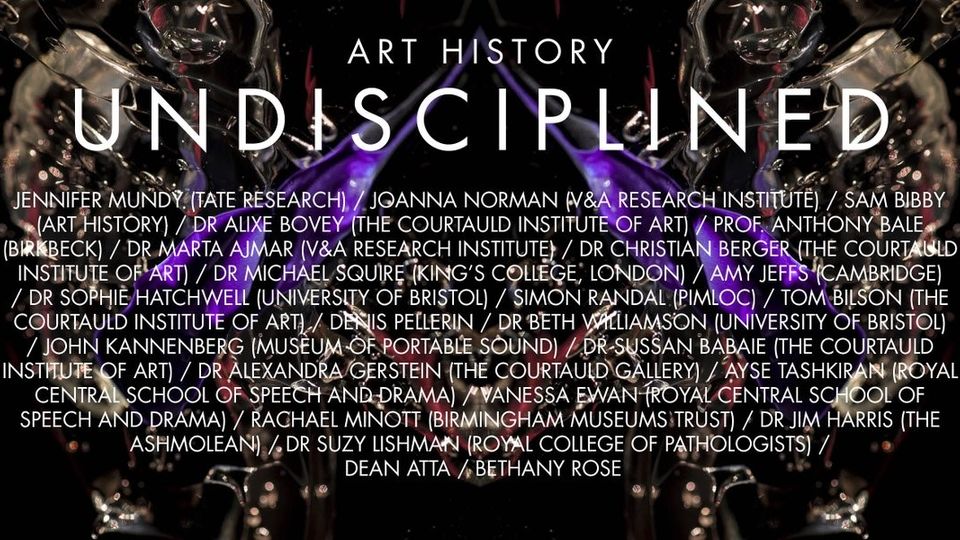
![Person standing against wall with one leg lifted towards body]() Photo by Lama Amine, MA Movement student
Photo by Lama Amine, MA Movement student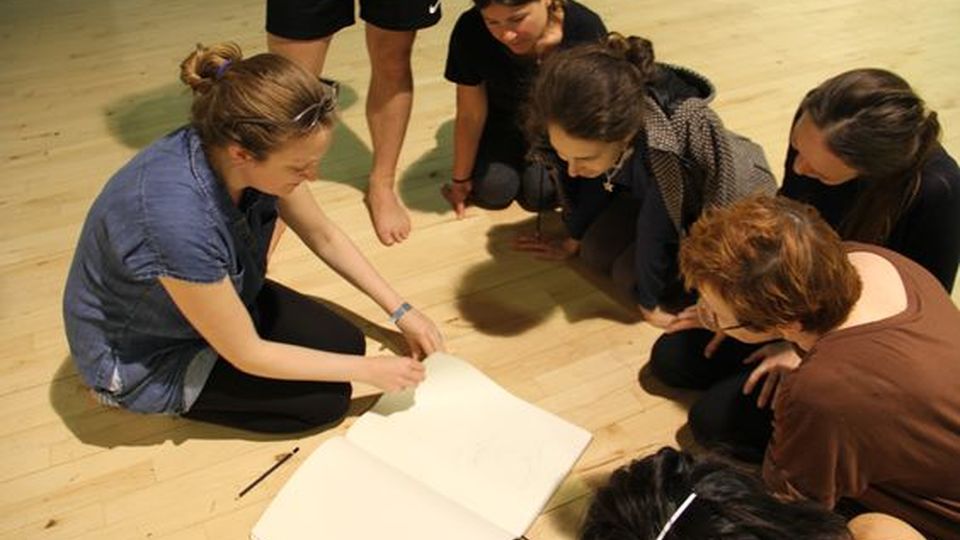 Co-researchers drawing and movement analysis
Co-researchers drawing and movement analysis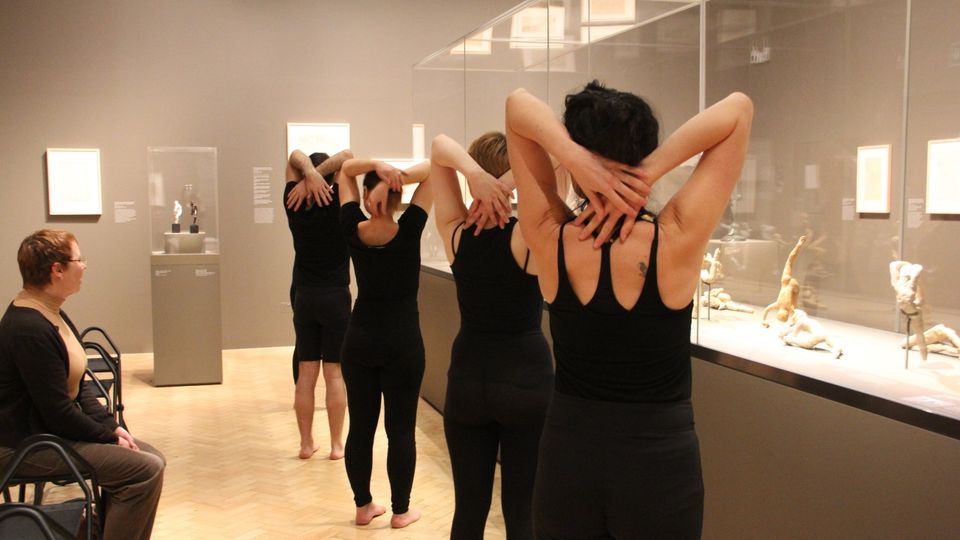 Movement with co-researchers and students in amongst Rodin's sculptures and drawings at the Courtauld.
Movement with co-researchers and students in amongst Rodin's sculptures and drawings at the Courtauld.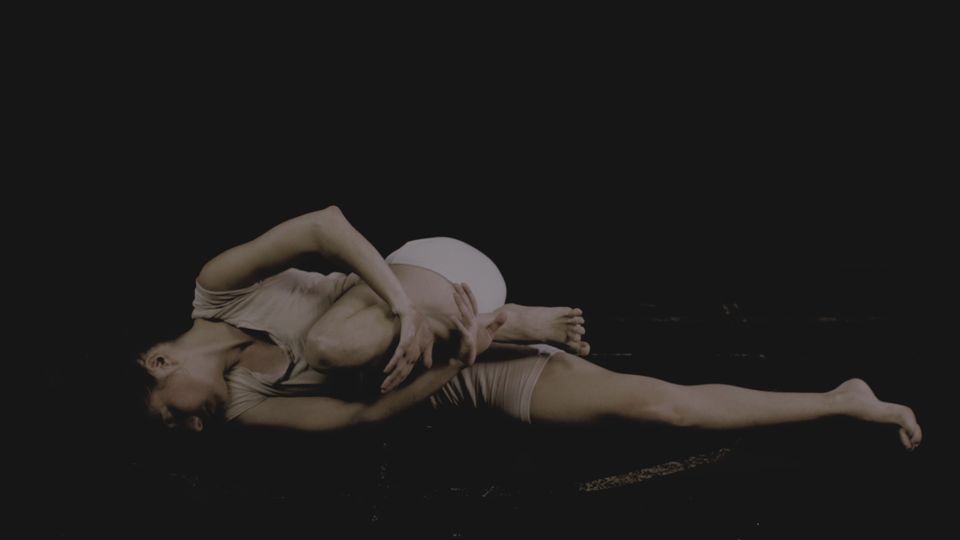 Still from a film of the research with MA Movement Student
Still from a film of the research with MA Movement StudentCo researchers Rachel Nouchi and Ana Marambio presented a paper entitled Understanding Visual Art Through Movement at the Movement: Body Brain Cognition Conference at Oxford University on July 7th 2017.
Viola Bruni MA Movement student connected through her acrobatics background to the sculptures and blogged about her experience of research.
June 2018 Art History Undisciplined at the Courtauld Institute. Joint conference presentation entitled’ Embodied Perspectives on Sculpture - A Case Study in Interdisciplinary Research’ by Dr Alexandra Gerstein, Vanessa Ewan and Ayse Tashkiran https://courtauld.ac.uk/event/art-history-undisciplined
Movement practitioners and neuroscientists gathered to discuss the connection between body and brain in a varied programme of science and arts-based presentations hosted by academics in the fields of neuroscience and movement provoking fascinating connections between the two fields.
We were invited to share our research drawing on material gathered over a two-year period as part of a research initiative between the International Centre for Movement and The Courtauld Institute to look at the movement dynamics in Rodin’s work in support of the exhibition, Rodin and Dance, The Essence of Movement, at the Courtauld Gallery (20thOctober 2016-January 22 2017).
Our research methods were developed using movement practices as a tool to deepen our understanding of the artworks in question; a collection of sculptures executed by Rodin towards the end of his life named posthumously as ‘Mouvements de Danse’ (1910-1915).
We wanted to find out how embodying the artwork through movement improvisation and physically drawing on paper, capturing moving bodies in a space, could deepen our understanding of what we were looking at. Using movement practices as a method of discovery led us to neuroscience and what it can offer the movement practitioner in terms of understanding the connections between movement, body and brain. ‘Artistic understanding always emerges from embodied simulation processes that incorporate the ongoing dynamics of brain, bodies and interaction with the world’ (Gibbs, 2013) clearly encapsulates our research process and what we were trying to achieve.
Compositional structures associated with creating art mirror many movement principles; space, weight, rhythm, balance, to name but a few, understanding such relationships through the discovery of Mirror Neurons’ (neurons that “mirror” the behaviour of the other, as though the observer were itself acting) and embodied simulation explain how the brain and body are fully engaged in this process.
With this in mind, by instigating movement laboratories, we set up a series of movement and drawing tasks to capture live movement to better understand the movement information embedded in Rodin’s drawings and sculptures. During each laboratory, through the exploration of muscular efforts, alignment, rhythm and directional impetus found in Rodin’s work, we attempted to get closer to the movement he was presenting. This in turn influenced the curator to create a gallery space where viewers could view exhibition through the eyes of movement. As co researcher curator, Dr Alexandra Gerstein confirms: “Not only does each figure compress several movements into one form, but altogether the series could be said to operate a piece of theatre, with one figure enacting a sequence of loosely related actions which can be observed in real time.”
Documentation suggests that Rodin’s models were in his studio for at least 3 hours moving freely. His aim was to capture movement while they were moving– thus many drawings – almost 5,000 in total, came from capturing live movement. Our research confirmed that as well as his drawings showing motion, his sculptures were often precariously off balance.
One of our earliest discoveries was to establish that many of the sculptures and drawing did not correspond to the laws of the human anatomy and such anomalies became increasingly revealing as we attempted to find the postures in our own bodies - at times, with minimal success. Many of the postures represented could only be reached with aid of support. For example, the movement research team used walls to balance against and props such as boxes and yoga squares. It was only after a longer period that the more subtle postures revealed themselves.
There are many factors that come to play when considering what composes the movement including the pull of gravity, weight, balance and the lines of tension, activated throughout the body when seeking a pose. Some of the sculptures exude a line of tension that prove the sculptures to be off kilter and the leg suspended in the air, thus the very nature of being out of balance might suggest falling or moving into another position. We often found that by changing the orientation of the pose, as Rodin did with his own work, the dynamics of the sculpture/drawing could be more clearly understood or re imagined.
We experimented at attempting to recreate the sculptures through isolating body parts given to individuals as separate tasks and regrouped as each person formed a human cluster that maybe moved us closer towards the essence of some of the sculptures on display. Rodin had created these sculptures through assemblages of moulded and cast body parts (taken from two source models) and through our practices, we had arrived at the same realization as the curator but through an embodied route.
Through movement practice and historical research, we established that the sculptures’ positions did not hail from Yoga or Ballet practices as maybe we initially assumed. Whilst we used similar principles of flexibility and strength that come from Yoga, we applied such principles using different dynamics through the space. Thus evolved a preparatory warm up for action- an acrobatic limber as part of the process reflecting the postures. Such preparation exercises themselves allowed for further discovery and the curators witnessed similar movements echoed in the drawings that they had found in the archives, representing precise moments of our exploration.
It was only by interrogating the sculptures through a series of movement laboratories over an extended period of time that we began to create a method of empathy and understanding directed to these specific works of art.We discovered that by moving our bodies in response to Rodin’s work with clear objectives, a deeper empathy or understanding of the artwork could be encountered and as such, an action-based agenda allowed us this experience. This became further targeted with one member of the team facilitating, directing and offering feedback in response to movement tasks. With such clear, focused direction, our responses to the sculptures and drawings became increasingly lucid. As Victor Gallese found in his research on mirror neurons: “In the case of the mirror neurons, what seems to matter most is that action must be goal orientated.” (Gallese 2010).
-
Year Three 2016-2017
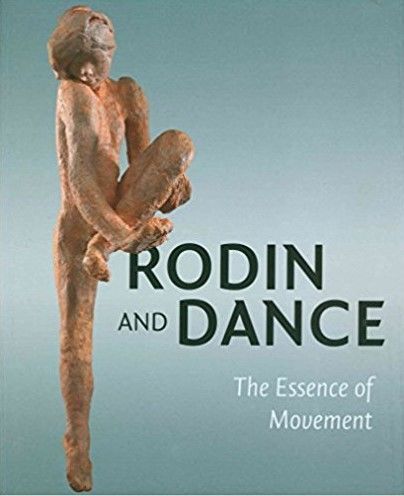 Rodin and Dance: The Essence of Movement
Rodin and Dance: The Essence of Movement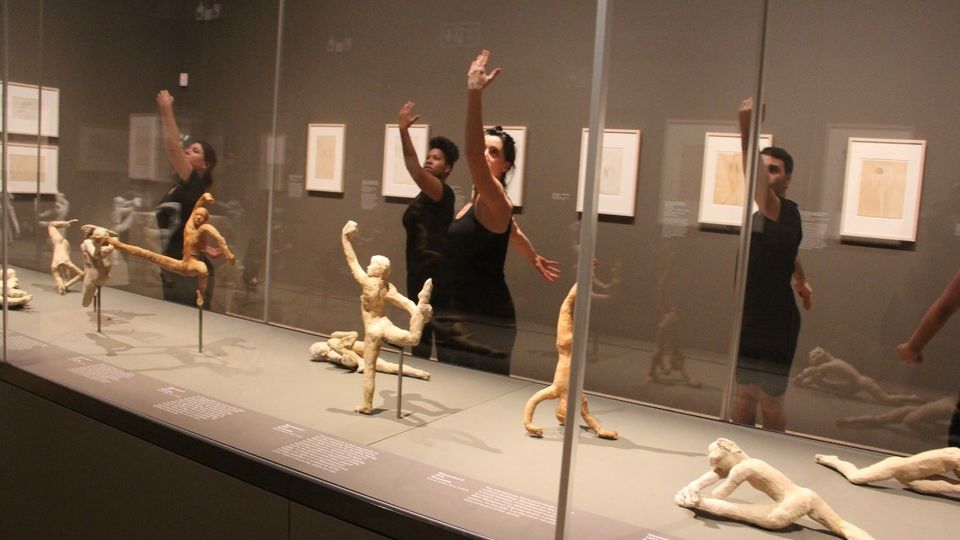
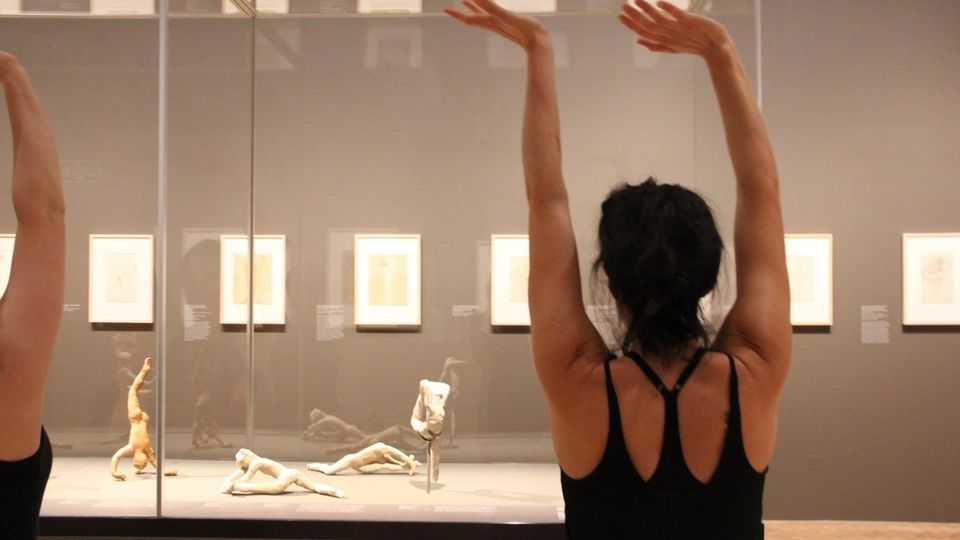
The Rodin Project research accelerated this year and accompanied the exhibition Rodin and Dance; The essence of Movement Courtauld Gallery Autumn 2016-17 curated by Dr Alexander Gerstein.
Four co-movement researchers shared aspects of our investigation with curators, movement directors and teachers, Central students, fine artists in a variety of settings. Our embodied findings were shared through movement workshops and sessions.
These included:
- Contribution of movement analysis from Vanessa Ewan and Ayse Tashkiran to the Catalogue of the exhibition written by Dr Alexandra Gerstein.
- Twilight Movement session in the gallery – movement practitioners and movement research team undertook movement sessions in the presence of the sculptures during the exhibition in the Courtauld Gallery. Ana Marambio led yoga inspired forms tailored to incorporate binding, balances and extensions in the exhibition space with curators from the Courtauld.
- December 2016 and January 2017 – we offered two movement workshops that used observation, warm up, learnt material in the form of a co-created port de bras, and movement principles extrapolated from the sculptures. Participants were then invited to take that experience into a visit to the exhibition.
- January 2017 Study Day at the Courtauld - as well as presenting the research project at the Courtauld, we also created a site-specific performance with our movement discoveries. Vanessa and Ayse created a movement response in the gallery with co researchers, Ana Marambio, Rachel Nouchi and with the participation of MA/MFA Movement students. This was a short performance deploying material created out of the research and improvisation inspired by selected sculptures.
- We completed a short film synthesising the research in movement with the collaboration of Ken Mizutani from RCSSD TSD department.
-
Year Two 2015-2016
![Drawing of person sitting with knees drawn up]() Drawing by movement researcher Rachel Nouchi
Drawing by movement researcher Rachel Nouchi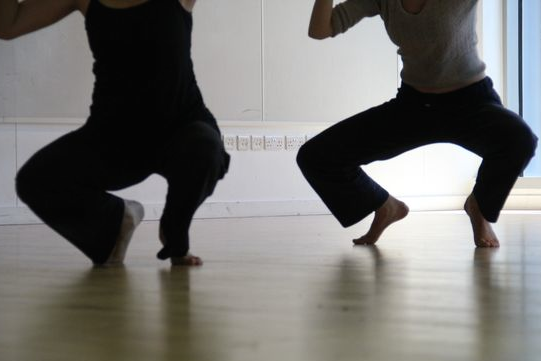 Movement Students in exploratory movement sessions; photo by movement student Milly Read
Movement Students in exploratory movement sessions; photo by movement student Milly Read![Student leaping with arms and one leg raised in rehearsal room in front of window]() Movement Students in exploratory movement sessions; photo by movement student Milly Read
Movement Students in exploratory movement sessions; photo by movement student Milly Read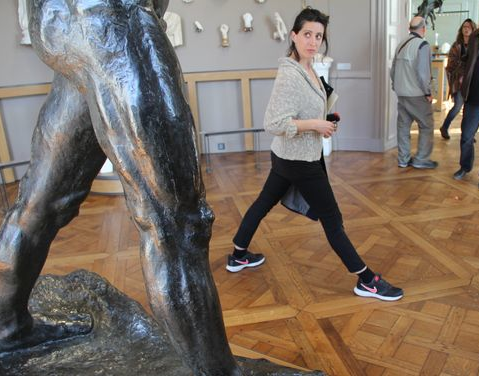 Ana Marambio (movement team) at the Rodin Museum Paris, responding to sculpture or Rodin’s Walking Man
Ana Marambio (movement team) at the Rodin Museum Paris, responding to sculpture or Rodin’s Walking ManAlongside hosting this series of workshops, the ICM began its first collaborative research project which combined a team of ICM movement practitioners (Vanessa Ewan, Ayse Tashkiran, Rachel Nouchi and Ana Marambio) with art curator Dr Alexandra Gerstein during preparation of an exhibition of Rodin sculptures entitled Rodin and Dance: the Essence of Movement at the Courtauld Gallery Autumn 2016-17. Over a period of two years we undertook a series of physical explorations through movement, observation and drawing with a variety of movement students, movement professionals and curators. En route we made discoveries about the life model that collaborated with Rodin, the postures of the sculptures, the methods of construction and the drawings. We captured and shared our findings through a film, five practical workshops at RCSSD and at the Courtauld; the exhibition catalogue, the education pack, study day with curators in January 2017.
Please see the link for details.
The ICM also curated the first practitioner intensive in January 2016 specifically to nurture and enhance movement director’s practice. This was a three-day immersion in practice led by dancer Jos Baker (of Peeping Tom Company). This intensive workshop activated ways of creating physical material for the stage; and introduced a range of methods for creating diverse material, spanning dance and theatre.
Please see the link for details on Jos’s work.
Movement Creation for Performance with Jos Baker
Wednesday 6th, Thursday 7th, Friday 8th January 2016
This intensive three-day workshop looked at ways of creating physical material for the stage; this workshop introduced a range of methods for creating diverse material for performance. Drawing from his background in physical theatre and dance Jos guided participants through tasks and methods for creating personal and unique dance/physical material, which has the potential to drive narrative and character driven work. Spanning dance and theatre; this workshop was designed for people significant experience in movement and performance.
Alongside the projects above the discursive focus shifted to movement practitioners who had been capturing and theorising their practice in written form with two workshops:
Year 2 Series
Action, Metaphor and Emotion
Workshop and discussion with Rick Kemp
Saturday 10th October 2015
Drawing upon his research in Embodied Acting Rick Kemp explored the integration of Action, Metaphor and Emotion through focused somatic awareness. The body, its actions, and its cognitive mechanisms link the three elements of theatre; Space, Time and Story. The three meet in, are defined by, and expressed through an actor’s body. Moving back and forth between guided play and the use of dialogue we will go beyond dualistic concepts of ‘psychological’ or ‘physical’ approaches to acting and discover ways in which embodied metaphors can stimulate specific emotions by linking physical action, thought and language. The work was pragmatic, exploratory and fun –a laboratory of play.
Integrative Performance Practice with Dr Experience Byron
27th February 2016
In the ICM’s next event Experience offered a practical insight into Integrative Performance Practice (IPP). Her approach to practice allows optimal ability while acting, singing/sounding, and dancing/moving, without the compromise of technical excellence. IPP is a way of working that shifts how performers engage with their training, conditioning, and performance disciplines. It synthesizes the various elements of performance work in order to empower the performer, as they practice across disciplines within any genre, style or aesthetic.
The IPP is designed not as a negotiation of various performing techniques, but rather as one practice through which any combinations of disciplinary expression can emerge with excellence. This workshop was an introduction the core practices and premises of the Integrative Performance Practice.
Experience Bryon
Experience Bryon was Senior Lecturer at the Royal Central School of Speech and Drama and served as Course leader for the MA in Performance Practice as Research.
Jos Baker
Jos Baker is a British dancer, teacher and choreographer currently based in Brussels. From 2008 to 2014; Jos worked for Peeping Tom as a dancer, actor and collaborator, principally with the productions 32 Rue Vandenbranden (2009), and A Louer (2011). Since then he worked for DV8 Physical Theatre on the production of John (2014) then began directing and performing in the promotional events for Petit Bateau’s Cedric Charlier collection.
Other stage work includes In the process of… (2009) by Zoi Dimitriou and Plastic Junkies (2014) by Antonin Comestaz.
On film Jos has made a music video for Forgot to live (2013) by Ay Wing, short film J’te Ramene (2014) directed by Yves Housmann and Biegga savkala duoddariid duohken lea soames (2006) by Elle Sofe Henrikseni as well as several commercials.
He has created several of his own works include: Afla (2008) Creature Man Don’t Tell Me (2008), Feedback (2009), What do you do? (2015) and Of no fixed abode (2015). He teaches internationally, offering a range of classes and workshops for professional dancers at institutions including SEAD, Ballet Junior de Geneve, PARTS Summer School, TrinityLaban, The Place, Amsterdam Theatre school, Deltebre Dansa, El Danseu Festival, Tripspace Projects, Ravnedans, Jetsummer and many others.
Jos started his dance training at the age of 7 with Oxford Youth Dance and then continued his formal education first at The Laban Center London and then at PARTS (Performing Arts Research and Training Studios) in Brussels.
-
Year One 2014-2015
In Year One 2014-2015 the focus was movement pedagogy. We curated a series of themed practical encounters where an in house movement tutor was paired with a visiting practitioner. The focus was on drawing out subtle differences in the practices and to highlight the international origins of the practices being used. All sessions culminated in an ‘open space’ where participants could reflect, discuss and analyse the practical work. And this in turn was captured in summaries and photos of these contrasting practices.
Workshop Series One: Rhythm and Sensation
Chisato Ohno and Debbie Green
Saturday 13th December 2014
- 10am-12pm and 12:30pm-2:30pm
- 2:30pm-4pm Open Space for dialogue and response facilitated by Ayse Tashkiran
Imagery and Sensation with Chisato Ohno
Chisato Ohno’s workshop was based on Gaga movement language developed by Ohad Naharin, director of the Batsheva Dance Company to help dancers reconnect to the way they move. Gaga is an evolving language of movement research designed to access an ever-expanding range of physicality through the imagery of sensation. It is a unique form of dance that is highly experiential and encourages individuality as well as joy in movement
Of Rhythms with Debbie Green
Debbie Green’s workshop offered an exploration of grounding and free flow integral to Roth’s Rhythm of Flowing and their relationship with Staccato, the next of Roth’s 5 Rhythms. The other three Rhythms of Chaos, Lyrical and Stillness were explored in relation to how they emerge from the first two. Debbie has found that this work offers the actor experience of dance that is not concerned with how it appears; and by moving with abandon the actor is enabled to identify when s/he does not allow freedom in movement. This session offers the actor an experiential grasp of the scope of different rhythms as movement qualities to embody.
Workshop Series Two: Energy in Action
Ian Morgan and Ali Hodge
Saturday 21st March 2015
- Open Space for dialogue and response facilitated by Ayse Tashkiran
Source and Flow with Ian Morgan
Releasing unexplored psychophysiological potential through play provides a rich way of opening the doorway to embodied performing. However, the process is necessarily different for each one of us. Through solo, couple and group exercise we sought to provoke the spontaneous, yet precise, reactions that stir the body-self in truly surprising ways. These exceptional moments are rarely repeatable but the creative flow from which they emerge can be nurtured and then visited again, and again.
Core Training and Relationship with Alison Hodge
Core Training identifies a common set of principles: Energetics, polyphonic attention and sensory engagement, all of which are explored through key themes: ground and weight, breath, relationships with others.The matrix of practical exercises offered through Core Training enable actors to explore these principles, developing their skills through physical and vocal partnerships. The emphasis was on the relational body whether that is in exploring responsiveness to another actor, the space, sound or thing. This practical work introduced participants to preliminary training exercises emphasizing the relational aspect of the work and elaborating on the key principles and themes.
Workshop Series Three: Time and Space
Glynn MacDonald and Vanessa Ewan
Saturday 27th June 2015
- 10am-12pm Workshop 1 and 12:30pm-2:30pm Workshop 2
- 2:30pm-4pm Open Space for dialogue and response facilitated by Ayse Tashkiran
Time and Space? with Glynn MacDonald
Drawing upon her experience as Master of Movement at the Globe theatre, Glynn MacDonald explored how the shared ecologies of the open-air stage shape the actor’s movement process. She offered insights into the movement dialogue and the energetic exchanges between actors and audiences.
Condensed, Imagined and Real with Vanessa Ewan
Drawing upon Laban’s language Vanessa Ewan’s workshop explored an aspect of the relationship of space and time for the actor. Aimed at movement practitioners from a wide variety of backgrounds this work looked at movement and spatial principles that activate the actor’s relationship to space.
Chisato Ohno
Chisato Ohno danced with Netherlands Dans Theater 2 for four years and then continued to Batsheva Dance Company where she was involved in four new creations and many other works of Ohad Naharin. She then joined Karas Company of Saburo Teshigawara for two premieres and tours of other repertory. She returned to London and has been teaching Gaga since 2005 and joined the faculty at London Contemporary Dance School in 2013.
Debbie Green
Debbie Green, Senior Lecturer teaches movement on the 3-Year Acting course at The Royal Central School of Speech and Drama ADD LINK
Alison Hodge
Alison Hodge is the Artistic Director of The Quick and The Dead, an international theatre research company. Since 2005, she has developed a physical approach to acting: Core Training. See the DVD: Core Training for the Relational Actor published by Routledge in 2013. The Company’s multi-media installation, You Looking At Me will open at the Gulbenkian Centre of Modern Art in Lisbon in 2016.
She was the Co-founder and Artistic Director of Theatre Alibi and an Artistic Associate of Gardzienice Theatre, Poland. Her publications include (2000) Twentieth Century Actor Training, Routledge, (2003) Hidden Territories: The Theatre of Gardzienice, Routledge, co-authored with Wlodzimierz Staniewski and (2010) Actor Training (second edition) Routledge.
Alison teaches at RADA and leads workshops internationally. She is an Honorary Research Fellow at Royal Holloway, University of London, where she was a Reader in Theatre Practice for twenty years.
Ian Morgan
Ian is currently Course Leader of the MA in Actor Training and Coaching at Royal Central School of Speech and Drama, an Associate teacher at RADA and a teaching fellow at Brunel University. ADD LINK
Glynn MacDonald
Glynn trained in the Alexander Technique in 1972. She is past Chairman of The Society of Teachers of the Alexander Technique (STAT). She has worked in the Actors Centre and the Field Day Theatre Company in Ireland, Dramaten in Stockholm, Norskspillersforbund in Norway, Holback Engstheatre in Denmark, Bremen Opera Company in Germany, Poland, Switzerland, Japan, Australia and the USA. Since 1997 she has been resident Director of Movement at Shakespeare’s Globe on all theatre productions. In 2002 she directed Transforming September 11th at the Linbury Studio, Royal Opera House for Peace Direct. She shared the Sam Wanamaker Award with Giles Block in 2011 for services to the Globe. She also works on the Jette Parker Young Artists Programme at the Royal Opera House, Covent Garden. In 2012 she was awarded the François Florent Prize in Paris. Glynn MacDonald is the Globe Associate-Movement at Shakespeare’s Globe, Bankside.
Vanessa Ewan
Vanessa Ewan, Senior Lecturer in Movement, BA Acting and co-course leader of the MA MFA Movement: Directing and Teaching.
Rick Kemp
Rick Kemp (aka Zoltowski) is the author of Embodied Acting: What Neuroscience Tells Us About Acting and co-editor and author of The Routledge Companion to Jacques Lecoq (forthcoming). He has over thirty years of experience as an actor and director gained in the UK, Europe, Canada and the USA. The co-founder and joint Artistic Director of London’s Commotion Theatre in the 1990s, he has worked with companies and theatres such as the Almeida, Complicité, The Tricycle, Riverside Studios, Edinburgh’s Traverse Theatre, Quantum, the Pittsburgh Playhouse, 404 Strand, Squonk Opera, Madrid’s Circulo de Bellas Artes, New York’s Perry St. Theatre, Toronto’s Harbourfront, Warsaw’s Teatr Polski, and the Bouffes du Nord. He holds an MA from Oxford University, and an MFA and a PhD from the University of Pittsburgh. He is the Head of Acting and Directing at Indiana University of Pennsylvania, USA, and a Fellow of the Salzburg Global Seminar on Neuroscience and Art.

